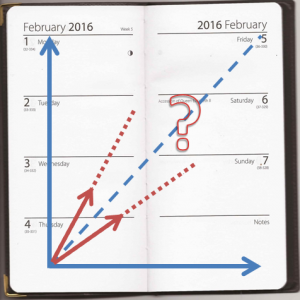
How are you getting on with your New Year resolutions? I’m doing pretty well with mine. I’ve been to the gym regularly week since the beginning of January, and several work projects are on track too. I have been “tracking” my achievements.
My question to you is:
“How do you know how well you are getting on?”
Why we need to track our projects
I said earlier that a New Year resolution should be SMART. Two of the letters are M for measurable and T for Time-bounded. If we are going to achieve our goal by the time we have set ourselves then we should be making progress towards it. If we are not making the progress we expect, then maybe we need to take action.
In order to monitor our progress we need to have some sort of tracking. We to be clear about our expectations (Plan) and we need to know what we have achieved (Actual). “Planned versus Actual” is what project tracking is all about, and it is one of the foundations of Project Management.
How do we track our project?
“Project tracking” sounds terribly formal but it doesn’t have to be complicated or bureaucratic. The key elements are “Plan”, “Actual” and periodic checking.
- The Plan, or expectation of my New Year Resolution is to take “regular exercise, once or twice a week”.
- The Actual is no more than a word in my (paper) diary.
- The monitoring is looking at the “ticks” on the last weekend of the month. There is no formal report.
My advice is always to use “the simplest thing which could possibly work”, and to build it into whatever routine you have. Make monitoring and tracking what you do a habit.
Reap the benefits of tracking your work
Monitoring your work and your projects allows you to take control. Don’t assume that you will always be “behind”. Sometimes you will be ahead of where you expect to be and sometimes the problem will not be productivity but the plan.
Start today! A little self-monitoring can increase your feeling of control and allow you to work more effectively.

